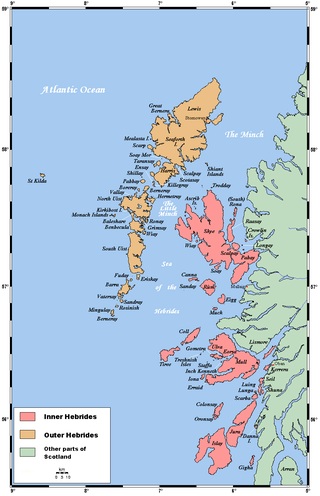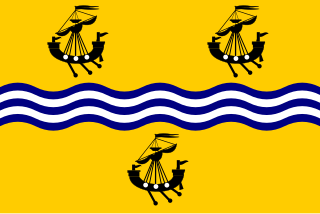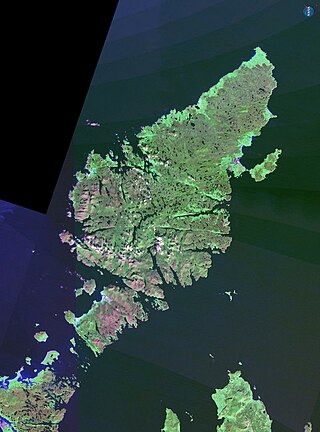History
Before the 1820s, the island was called Eilean na Cille ("church island"), [1] and there is evidence of a church, possibly dedicated to the Virgin Mary, near the site of the present cottage. [2] [3] Eilean Mhuire, one of the other islands in the Shiants, also takes its name from Mary.
In the mid-18th century, 40 people were living there, but by 1770 they had all left. In the 1820s a shepherd and his wife were resident, but, by 1842, they too had gone. From 1862 to 1901, another shepherd, Donald Campbell, and his wife and two daughters lived there. The daughters, Mòr and Catriona, were apparently very beautiful, and attracted the attention of visiting fishermen and yachtsmen alike. [1]
In 1937, the islands were acquired by Nigel Nicolson, then an undergraduate at Oxford, who — like the former owner, Compton MacKenzie, was later a writer, publisher and politician. Nicolson's son, the writer Adam Nicolson, published the definitive book on the islands, Sea Room. The Shiants now belong to Adam's son, Tom. Sheep belonging to a Lewis crofter graze all three islands. The simple bothy restored by Nigel Nicolson on Eilean an Taighe is currently the only habitable structure on the islands. [4]

The Hebrides are an archipelago off the west coast of the Scottish mainland. The islands fall into two main groups, based on their proximity to the mainland: the Inner and Outer Hebrides.

The Islands of the Firth of Clyde are the fifth largest of the major Scottish island groups after the Inner and Outer Hebrides, Orkney and Shetland. They are situated in the Firth of Clyde between Argyll and Bute in the west and Inverclyde, North Ayrshire and South Ayrshire in the east. There are about forty islands and skerries. Only four are inhabited, and only nine are larger than 40 hectares. The largest and most populous are Arran and Bute. They are served by dedicated ferry routes, as are Great Cumbrae and Holy Island. Unlike the isles in the four larger Scottish archipelagos, none of the isles in this group are connected to one another or to the mainland by bridges.

The Outer Hebrides or Western Isles, sometimes known as the Long Isle or Long Island, is an island chain off the west coast of mainland Scotland. The islands form part of the archipelago of the Hebrides, separated from the Scottish mainland and from the Inner Hebrides by the waters of the Minch, the Little Minch, and the Sea of the Hebrides. The Outer Hebrides are considered to be the traditional heartland of the Gaelic language. The islands form one of the 32 council areas of Scotland, which since 1998 has used only the Gaelic form of its name, including in English language contexts. The council area is called Na h-Eileanan an Iar and its council is Comhairle nan Eilean Siar.

The Slate Islands are an island group in the Inner Hebrides, lying immediately off the west coast of Scotland, north of Jura and southwest of Oban. The main islands are Seil, Easdale, Luing, Shuna, Torsa and Belnahua. Scarba and Kerrera, which lie nearby are not usually included.

Muckle Roe is an island in Shetland, Scotland, in St. Magnus Bay, to the west of Mainland. It has a population of around 130 people, who mainly croft and live in the south east of the island.

The Shiant Islands or Shiant Isles are a privately owned island group in the Minch, east of Harris in the Outer Hebrides of Scotland. They are five miles southeast of the Isle of Lewis.
Adam Nicolson, is an English author who has written about history, landscape, great literature and the sea. He is also the 5th Baron Carnock, but does not use the title.

Eilean Mhuire is the most easterly of the Shiant Islands in the Outer Hebrides.
Eilean Shona is a tidal island situated at the entrance of Loch Moidart, on the west coast of Scotland, just north of the Ardnamurchan Peninsula. The island is 525 hectares in area, with the highest point being Beinn a' Bhàillidh at 265 metres (869 ft). There are five other peaks of over 150 metres (490 ft) and views of the sea and off-shore islands including Rhum, Eigg and Skye. It is reached by a short boat ride from the mainland. The modern name may be from the Old Norse for "sea island". The pre-Norse Gaelic name, as recorded by Adomnán was Airthrago or Arthràigh, meaning 'foreshore island', similar to the derivation of Erraid.

Calve Island is an uninhabited low-lying island off the east coast of the Isle of Mull in Argyll and Bute on the west coast of Scotland. A whitewashed farmhouse with substantial outbuildings stands on the western shore, used as a summer residence. The island is 1+1⁄4 miles in length, and 1⁄2 mile wide at its widest point. Calve is owned by the Cotton family who make use of it in the summer months.

Garbh Eilean is one of the Shiant Islands at the south end of the Minch on the west coast of Scotland.

Eilean Mòr is the largest of the Crowlin Islands in the Inner Sound off the Isle of Skye, Scotland.

Eilean Trodday is an island in The Minch just off the north coast of the Trotternish peninsula of Skye in Scotland.

Eilean Tigh is a tidal island in the Sound of Raasay of Scotland, that lies between Rona and Raasay.

Eilean Meadhonach is the second largest of the Crowlin Islands, located in the Inner Sound off the island of Skye, Scotland.

Description of the Western Isles of Scotland is the oldest known account of the Hebrides and the Islands of the Clyde, two chains of islands off the west coast of Scotland. The author was Donald Monro, a clergyman who used the title of "Dean of the Isles" and who lived through the Scottish Reformation. Monro wrote the original manuscript in 1549, although it was not published in any form until 1582 and was not widely available to the public in its original form until 1774. A more complete version, based on a late 17th-century manuscript written by Sir Robert Sibbald, was first published as late as 1961. Monro wrote in Scots and some of the descriptions are difficult for modern readers to render into English. Although Monro was criticised for publishing folklore and for omitting detail about the affairs of the churches in his diocese, Monro's Description is a valuable historical account and has reappeared in part or in whole in numerous publications, remaining one of the most widely quoted publications about the western islands of Scotland.
This page is based on this
Wikipedia article Text is available under the
CC BY-SA 4.0 license; additional terms may apply.
Images, videos and audio are available under their respective licenses.















